

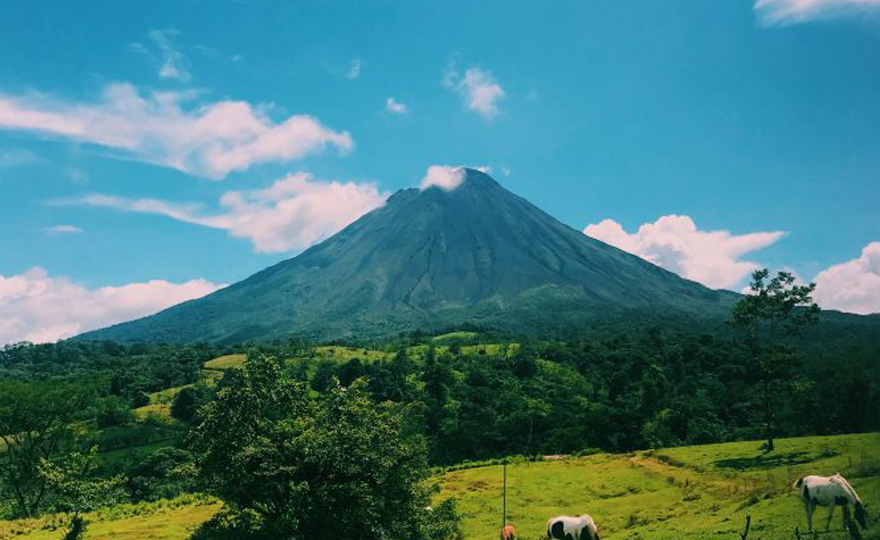
Here is the second piece of everything you need to know about Costa Rica. In this part, I will review some cultural aspects of the Pura Vida country and provide an overview of recreational activities in Costa Rica that are tuanis.
Where am I going exactly? How do I get around?
If you want to scope out in advance what area of Costa Rica you are heading to, the exact location is Santa Rosa de Santo Domingo de Heredia. Santa Rosa is the smaller neighborhood, Santo Domingo is the city, and Heredia is the province (but there is also the city of Heredia). It is a pretty good location because you are about 20 minutes from San Jose, in one direction, and 20 minutes from Heredia, in the other direction. Santa Rosa has a train stop right in the neighborhood, and there are plenty of bus stops nearby, too, that can get you around easily. The routes can be intimidating to navigate at first, but don’t be afraid to learn by trial and error. Worst comes to worst, you can always call an Uber or taxi, (or DiDi! — a new app similar to Uber) to come to your rescue.
What do I do with all my time in Costa Rica?
Aside from classwork and internship, you will have plenty of time to experience the culture of Costa Rica by engaging with your host families, being involved with activities hosted by Casa Adobe, and travelling! I recommend creating a bucket list of all the places you want to see and things you want to do in Costa Rica early on so you can adequately plan for each item. If you start feeling restless, branch out and visit local activities in Santo Domingo’s park, like bailles (P.S. everyone dances in Costa Rica) or conciertos. You can also venture out to San Jose or Heredia. San Jose has a larger nightlife, but the city isn’t really all that pretty, let’s say. Some locals prefer traveling to Heredia, which is more recently developed and has a cleaner look. Keep an eye out for cultural activities going on locally and nationally. The advantage of being so close to San Jose is that you can go to sporting events or concerts for famous Latin American artists (think Marc Anthony)!
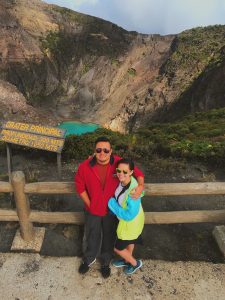
During Fall break, my brother visited me and we visited several landmarks in Costa Rica, one of them being the Irazu Volcano, which features a lagoon inside the crater.
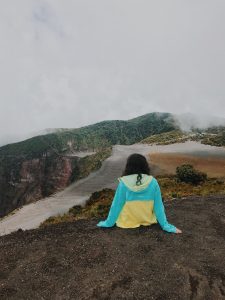
Where do you get to visit while you’re in Costa Rica?
There are a ton of websites and blogs online that give recommendations about the top places to visit in Costa Rica. For transportation, this website was very useful for getting around. Truthfully, there’s so much to see but you can really make the most of your time if you plan properly. Here is a comprehensive list of all the places I travelled to for my own leisure:
In San Jose/Heredia Provinces:
1. Barva Volcano
2. Irazu Volcano
3. San Jose Central Market
4. Oxigeno (This is just a mall, but it has a very cool mirador of the Central Valley)
5. Zoológico y Jardín Botánico Nacional Simón Bolívar Park
6. Jade Museum
7. Museums of the Central Bank (Pre-Colombian Gold Museum/The Numismatic Museum/Other Temporary Exhibits)
I found this from the website. “Admission is 2,000 Colones for citizens and residents, and 5,500 Colones for foreigners. Admission is free on Wednesdays. Admission is 2-for-1 on Sundays for citizens and residents with Costa Rican I.D. Admission is free for children under 12, students wearing their uniform or with school I.D. and retired citizens.”
8. Basilica of Our Lady of the Angels in Cartago
9. National Theater of Costa Rica — Guided Tour and a show (1001 Noches)
10. Estado Nacional // La Sabana Park
Tip: Have the UCR issue you a student ID, and you can get student discounts at certain locations.
In Other Provinces:
1. La Fortuna, Alajuela — Arenal Volcano
2. Manuel Antonio, Puntarenas — Manuel Antonio National Park
3. Jaco, Puntarenas
4. Santa Cruz, Guanacaste
5. Puerto Viejo, Limon
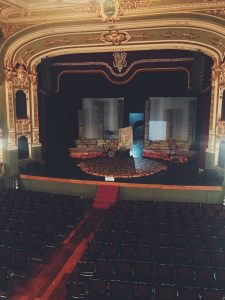
The National Theater is one of the many gems of Costa Rica. In the guided tour you learn that the theater is used for many important, national events, like the President’s inauguration.
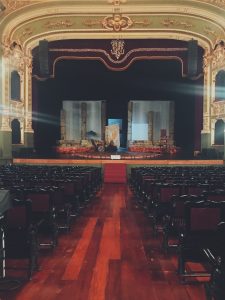
It is also ranked as one of the most beautiful buildings in the world.
As a cohort, the group goes sightseeing. Here are the places we went in Fall 2019 in Costa Rica:
|
5. Cahuita, Limon |
| 2. National Monument (and more) | 6. Bri Bri, Limon |
| 3. Contemporary Art Museum | 7. Tortuguero, Limon |
| 4. Guayabo National Monument | 8. Tacares Waterfall |
With Heidi, students also visit untraditional tourists locations like indigenous communities and refugee communities. They may not be glamorous areas, but they are very eye-opening and experiences for personal growth. (Bolded items are my favorite locations.)
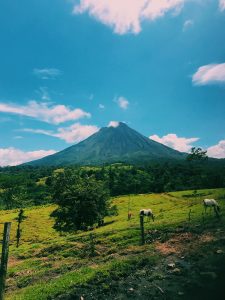
At this site, visitors can enjoy walking across hanging bridges in the National Park, bathing in hot thermal pools, or zipline through the jungle.
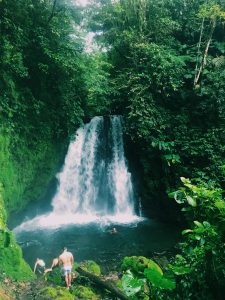
At this site, visitors can enjoy walking across hanging bridges in the National Park, bathing in hot thermal pools, or zipline through the jungle.
Random pieces of advice for those planning on going abroad?
While I would like to say that everything about studying abroad in Costa Rica was perfect, the reality is that you experience some growing pains while here. The best way to maneuver any uncomfortable situation is to ask for help and open up to someone you trust, whether it be Heidi, a fellow peer, someone in your host family, etc. Some lessons are bigger than others, but here’s some tidbits that may be useful.
Weather
In the Central Valley, it gets chilly at night. If you are traveling to Costa Rica in the fall semester, make sure to bring some sweaters or light jackets. Even during the day, you won’t want to wear summer clothes, like flip flops or shorts because it is not beach weather in San Jose. The fall semester coincides with the rainy season, so ALWAYS have an umbrella with you, that’s the number one rule before leaving your house in the rainy season. You may also want to bring other attire that is water-resistant.
Shoes
You will do a lot of walking throughout the semester, so bring walking shoes that are supportive, and it may be smart to leave behind any shoes you don’t want to get dirty or ruin. The sidewalks and streets are not that great here, so the most important element is functionality. Also, if you wear sandals on a cold, rainy day, you will stick out as a foreigner. Most people wear closed-toed shoes here, which is also good to keep in mind when you go to your internship.
Host Families
One major culture shock may be living with a host family. Not only is it a family that is not your own, the “parenting” of parents in Costa Rica is very different than US parenting. Some people love the experience, whereas others may find it difficult. In some ways, it is like being in highschool again, where you have to be conscious of how frequently you go in and out of the house, what time you come home at night, eating all the food on your plate, etc. The best way to prevent any uncomfortability in a homestay is to, first, be clear in your application what your hobbies are, what kind of food do you like and don’t like, what kind of environment do you prefer, all the details that will help Heidi pair you with the right family. Second, open communication is best, especially with Heidi. She will always help you navigate any situation relating to cultural cues, to arranging a doctors visit, to handling difficult conversations… with anything you need help with.
Costs of Living
In relation to other neighboring Central American countries, Costa Rica is very expensive. I love going to the malls but I never buy anything because everything is overpriced. Be smart and save money where you can. Opt to make lunch at home, don’t buy things in touristy spots where things are overpriced, use the bus versus Uber; this will help you save money to spend on experiences like going out with friends or travelling. Beware that some tourist activities are pricey and foreigners often get upcharged a ton versus residents.
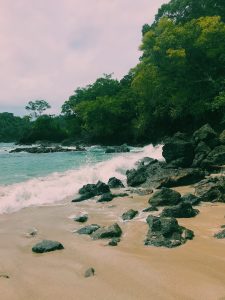
Manuel Antonio is known for having some of the most beautiful beaches in the country.
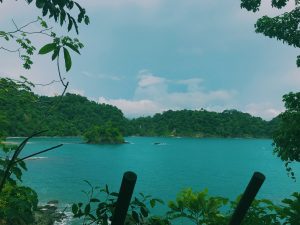
he National Park is extensive and has many breathtaking views.